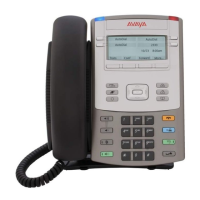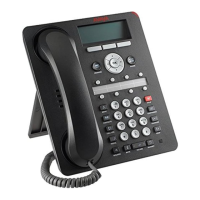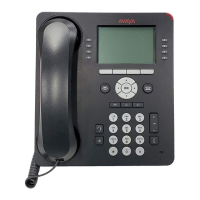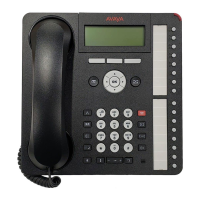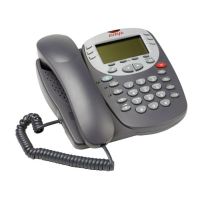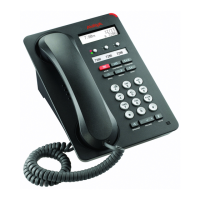Do you have a question about the Avaya IP500 V2 and is the answer not in the manual?
Details on components outside basic system installation, requiring separate documentation for proper setup and configuration.
Explains the different operating modes supported by IP500 V2 control units, including Standard and Basic Editions.
Describes the base of an IP Office system, the control unit, and its customization options with base cards and daughter cards.
Details the typical components of an IP Office system based on an IP500 V2 control unit.
Describes the IP500 base cards that fit into the control unit's slots for adding ports and resources.
Details IP500 trunk cards that can be fitted to base cards to support trunk connections.
Describes IP400 trunk cards that can be used with IP500 and IP500 V2 control units via a Legacy Card Carrier.
Information on external expansion modules used to add additional ports to IP Office systems.
Covers the power supply units and cables required for IP Office control units and expansion modules.
Details on mounting IP Office control units and expansion modules using optional kits.
Explains the requirement for feature keys and how licenses are entered and managed in the IP Office configuration.
Lists the supported IP Office phones and phone add-ons, with availability potentially depending on location.
Discusses the converged telephony system, combining PABX and IP data systems, and factors for VoIP operation.
Explains the use of voice compression channels for converting audio codecs between IP and non-IP devices.
Lists the country locales supported by IP Office standard modes, which affect system settings and prompts.
Details the IP Office applications available on DVDs, covering administration and user applications.
Describes applications used to program and maintain IP Office systems, typically running on a PC.
Covers applications that operate in parallel with user telephones, such as one-X Portal and SoftConsole.
Details applications for recording and playing voicemail messages, including Embedded Voicemail and Voicemail Pro.
Discusses third-party applications for call logging and accounting, supported by an SMDR output.
Details applications for call center management, such as Customer Call Reporter.
Covers CTI applications like TAPILink Pro and TAPI WAV driver for voice processing.
Information on Avaya University training courses for IP Office and associated applications.
Provides a list of Avaya and third-party web sites for supporting IP Office information.
Details the two types of analog extension power failure ports and their functionality during power loss.
Specifies the environmental conditions required for the planned location of an IP Office system installation.
Details the installation space requirements for IP Office control units and modules, including clearance.
Additional requirements for wall mounting IP Office units, emphasizing surface preparation and kit usage.
Covers rack mounting requirements for IP Office control units and expansion modules, including slot space.
Describes accessing the IP Office system via web browser for maintenance and basic configuration.
Details the IP Office Administration suite, including required applications and PC specifications for installation.
Explains how to connect an installation PC directly to the IP Office control unit for configuration.
Provides instructions on how to start and connect to the IP Office system using IP Office Manager.
Guides on how to start the System Status Application for inspecting system status and viewing alarms.
Details how to start System Monitor for detailed activity tracing and troubleshooting.
Lists the general tools and additional equipment needed for IP500 V2 installation.
Emphasizes reading the manual and other installation documentation before starting.
Covers actions to perform on the System SD card prior to installation for pre-configuring the system.
Details the process of fitting IP500 base cards and trunk daughter cards into the control unit.
Instructions for wall mounting IP500, IP500 V2 control units, and expansion modules using specific kits.
Guidelines for rack mounting IP Office control units and expansion modules into standard 19" rack systems.
Procedure for connecting external expansion modules to the IP Office control unit before applying power.
Explains the importance of grounding connections for IP Office control units and expansion modules.
Details how a new IP Office system determines its IP address and DHCP mode settings.
Outlines the process of starting the system, inserting the SD card, and powering up.
Describes connecting analog, ETR, and DS phones to the IP Office system.
Guide on how to enter license keys into the IP Office configuration to activate features.
Explains how to set the system locale, affecting trunk settings, phone displays, and voicemail prompts.
Details on how to change the IP address and DHCP mode settings for the IP Office system.
Instructions on changing default passwords for configuration access to enhance system security.
Covers changing extension numbers for all users or individual users on IP Office standard mode systems.
Explains how to disable unused trunks or trunk channels to prevent issues with outgoing calls.
Details on setting the digital trunk clock source for synchronization of call signalling.
Covers setting trunk prefixes for outgoing calls and how they are used for incoming call routing.
Describes how to set the port mode for DS16B/30B modules to support DS phone or TCM phone ports.
Process to register an IP500 V2 system for remote support and maintenance via IP Office Web Manager.
Details the mandatory System SD card for IP Office firmware, configuration, and Embedded Voicemail.
Describes the optional SD card slot for maintenance actions, software upgrades, or backups.
Specifies requirements for non-Avaya SD cards used in the Optional SD slot.
Explains the process of booting the IP500 V2 control unit using firmware files from SD cards or non-volatile memory.
Describes the process of formatting and creating an IP Office SD card for system use.
How to view the folders and files on the System SD card and Optional SD card using IP Office Manager.
Details the process of copying the /primary folder contents to the /backup folder on the System SD card.
Explains how to copy contents from the /backup folder to the /primary folder on the System SD card.
Describes copying all files from the System SD card to the Optional SD card, overwriting existing files.
Process to copy configuration and license files from the Optional SD card to the System SD card.
Details copying software files from the Optional SD card to the System SD card, excluding configuration and license files.
Procedure for safely shutting down and removing memory cards from a running IP Office system.
Describes the correct procedure for shutting down an IP Office system for maintenance.
Explains how to restart the system using IP Office Manager, Reset button, or a system phone.
Details processes for replacing, adding, or removing components like cards and expansion modules.
Processes to erase configuration and security settings, restarting the system with default settings.
Instructions for resetting system security settings, including service user accounts.
Procedures for replacing the existing system configuration with a new prepared configuration.
Methods for upgrading the system to a new release of IP Office core software using various tools.
Supported scenarios for connecting wired extensions outside the main building, requiring protection.
Details on using the EXT O/P port for controlling external relay systems like door entry switches.
Information on SNMP for network monitoring and management of IP Office devices.
Explains the function of the Reset button for pausing startup or erasing configuration/software.
Describes using the RS232 port for system maintenance processes like configuration and security defaulting.
Procedures for erasing the control unit's core software, which involves BOOTP requests for new firmware.
Lists the general tools and additional equipment needed for IP500 basic installation.
Emphasizes reading all relevant documentation, including technical bulletins and web resources.
Procedure for unpacking equipment, checking for damage, and verifying parts delivery.
Details the process of installing IP500 base cards and trunk daughter cards into the control unit.
Describes preparing IP500 trunk daughter cards for fitting onto IP500 base cards.
Explains how to prepare IP400 cards for use with the IP500 Legacy Card Carrier.
Step-by-step guide for inserting prepared IP500 base cards into the control unit slots.
Instructions for inserting the mandatory smart card feature key dongle into the IP500 control unit.
Procedure for powering up the IP Office control unit to its default configuration state.
Describes the normal power-on sequence for the CPU LED and troubleshooting error indications.
Guide on upgrading the IP500 control unit to the required level of IP Office software.
Process for receiving a configuration from an IP Office system running IP Office 3.2 or higher software.
Details on adding license keys individually or importing a License.csv file into the configuration.
Procedure for connecting external expansion modules to the IP Office control unit and restarting the system.
Guidelines for rack mounting IP Office control units and expansion modules into standard 19" rack systems.
Instructions for wall mounting IP500, IP500 V2 control units, and expansion modules using specific kits.
Details the features, capacity, and specifications of the IP500 V2 control unit.
Describes the IP500 base cards that fit into the control unit's slots for adding ports and resources.
Details the IP500 trunk daughter cards that attach to base cards for trunk connections.
Information on IP500 external expansion modules supported by IP Office Release 9.0.
Explains the role of feature keys, including SD cards and smart cards, for system operation and licensing.
Describes IP400 trunk cards that can be used with IP500 and IP500 V2 units via a Legacy Card Carrier.
Details IP400 internal cards like Embedded Voicemail Memory Cards and Voice Compression Modules.
Information on IP400 external expansion modules supported by IP Office Release 9.0.
Lists the supported IP Office phones and their features, including fixed function keys and variants.
Details various phone add-on modules like button modules, power supplies, and interface modules.
Outlines requirements for various IP Office applications, with references to specific installation manuals.
Provides outlines of IP Office applications and their PC requirements.
Describes the different port types found on IP Office systems, including their function and connection details.
Covers current licenses used by IP500 and IP500 V2 systems, including status, types, and examples.
Summarizes the hardware components supported across different IP Office core software releases.
Information regarding the lithium battery fitted to the real-time clock, including replacement warnings.
Details lightning protectors, hazard symbols, and precautions for installing telephone equipment.
Specifies the trunk interface card types that must be fitted in IP Office control units for approval validation.
Guidance on obtaining further information and product updates from Avaya resources.
Classifies Avaya IP Office system ports and their safety ratings, including SELV and TNV types.
Details compliance with EMC Directive and potential radio interference in domestic environments.
Provides regulatory instructions for use in Australia, Canada, China, European Union, and New Zealand.
FCC compliance information, including product identifiers, REN usage, and means of connection.
Details transmit and receive gain settings for PRI/T1 and Analog ports, emphasizing qualified personnel adjustment.
| Full duplex | Yes |
|---|---|
| Data transfer rate | 0.1 Gbit/s |
| Ethernet LAN (RJ-45) ports | 2 |
| Input voltage | 100 - 240 V |
| Input frequency | 50/60 Hz |


